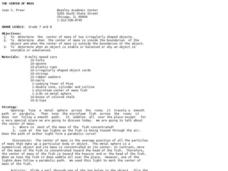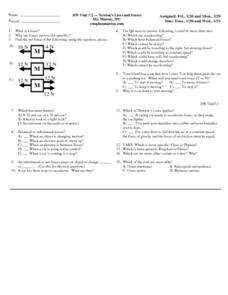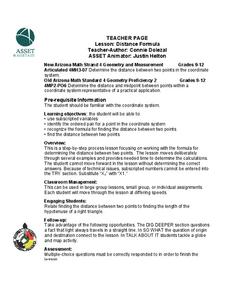Curated OER
The Center of Mass
Young scholars determine the center of mass of two irregularly shaped objects, determine when the center of mass is inside or outside the boundaries of the object, determine when and/or why an object is stable, balanced, unstable or...
Curated OER
Sound
Fifth graders explore and examine the basic properties of sound. In pairs, they speak through a balloon and listen to the sound vibrations, and listen to a ticking clock or watch through a variety of materials and identify the...
Curated OER
Newton's Laws and Forces
In this Newton's laws and forces worksheet, high schoolers answer 11 questions about inertia, vectors, force, and acceleration using Newton's laws. They also answer 3 questions about classification of species.
Curated OER
Storms and Extreme Weather
Students explore hurricanes and tornadoes by conducting an experiment. In this weather pattern instructional activity, students define many extreme weather vocabulary terms and discuss the relationship with static electricity. Students...
Curated OER
The Great Hubble
Students explain how Hubble telescope captures images from space. In this space science instructional activity, students use the internet to view space photos. They debate on an issue raised by the teacher.
Curated OER
Characterization in The Ponder Heart:A Collaborative Speaking Unit
Pupils assess fellow student's oral narrative tales. They discuss the attributes that marked the "best" narratives. They compose their own narrative tales and interview family members. They make a final speaking presentation to the...
Curated OER
Astronomer sees a 'Brake' in Cosmic expansion
Seventh graders examine and read an article. In this investigative lesson students discuss questions about the article and complete an activity.
Curated OER
The Power of Compounding
Sixth graders examine the concept of compounding interest on invested money. They explore how much interest their money would earn through compounded interest. Students conclude that they should invest early and often.
Curated OER
Refraction and Lenses
For this lenses worksheet, students will review refraction through lenses by reading pairs of statements and circling the correct ones. Then students will read 9 statements and indicate if the statement is referring to a concave lens,...
Curated OER
Acceleration and You
Students discuss and view examples of acceleration. They work together to determine acceleration rates in two ways. They analyze their data and discuss.
Curated OER
Snell's Law Proof
In this proof worksheet, students use differentiation and the low of refraction to prove that the path of minimum time occurs when dt/dx = 0. The complete solutions is provided.
Curated OER
Geometry: Practical Applications of the Distance Formula
Learners, working independently and in groups, apply the distance formula to practical situations. After solving various problems, students in pairs design coordinate planes from the school blue print to measure the distance from the...
Curated OER
Count and Non-count Nouns
In this count and non-count nouns worksheet, students complete 8 sentences by choosing the noun or nouns that make sense. They choose from 4 choices for each question.
Curated OER
Intermediate Matching - Driving
In this driving terms worksheet, students draw a line from the driving terms to the matching definitions. There are 11 terms to match on this worksheet.
Curated OER
Applications of Parabolas
In this algebra worksheet, 11th graders rewrite word problems using algebraic symbols. They relate parabolas to the real world and calculate the breaking distance using the distance formula they come up with. There is answer key.
Curated OER
Locomotion, Time And Shapes
Students practice the concepts of time and rhythm using drum beats. They also create body shapes using verbal cues. The shapes made include stretched, curled, angular, or twisted. The rhythm of beats is increased or decreased to explore...
Curated OER
Our Solar System
In this solar system instructional activity, students read about the planets, asteroids, meteoroids, comets, and the moon. Then students complete 25 multiple choice, 4 true or false, and 3 short answer questions.
Curated OER
Distance Formula
Students calculate the distance formula. For this geometry lesson, students find the distance between two points on a coordinate plane. They identify the four different quadrants.
Curated OER
A DISAPPEARING ACT Astronomy: Do Stars Always Shine?
Students observe why stars are not visible during the day with a classroom demonstration using an index card punched with holes.
Curated OER
Tracking Ozone
Students track an ozone event in Groton, CT. They compare weather changes and the subsequent ozone levels. Also, they make comparisons and determinations about ozone levels.
Curated OER
Astronomical Scales
Students describe the different units of measurement. For this space science lesson, students calculate astronomical distances using a scale. They explain the significance of using scientific notation in expressing very small or...
Curated OER
The Rumblin' Road
Learners determine the distance to a lightning strike. They complete a number of examples that determine the distance to a thunderstorm or lightning strike. They focus on safety during a thunderstorm.
Curated OER
Life Without Flight
Students keep a journal for an intire week recording their observations of the ways aircraft affect society, The students discuss their findings and categorize them into areas such as military, commercial, research, and so on.
PBS
Pbs: Nova: Time Travel: Think Like Einstein
Addressed with questions about relative speed and the speed of light, students begin to "think like Einstein" while exploring the science behind the mystery of time travel.

























